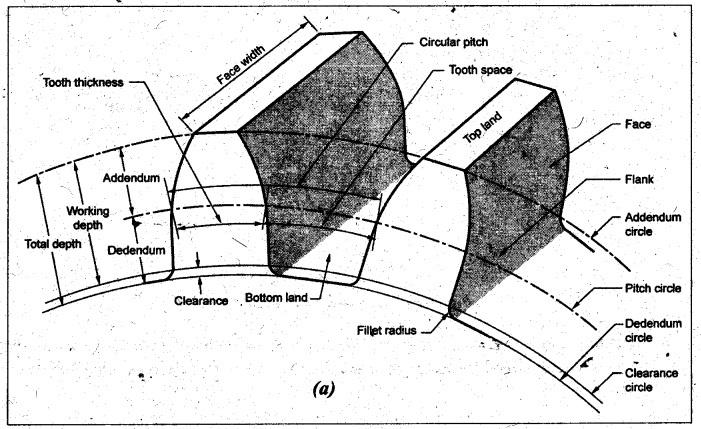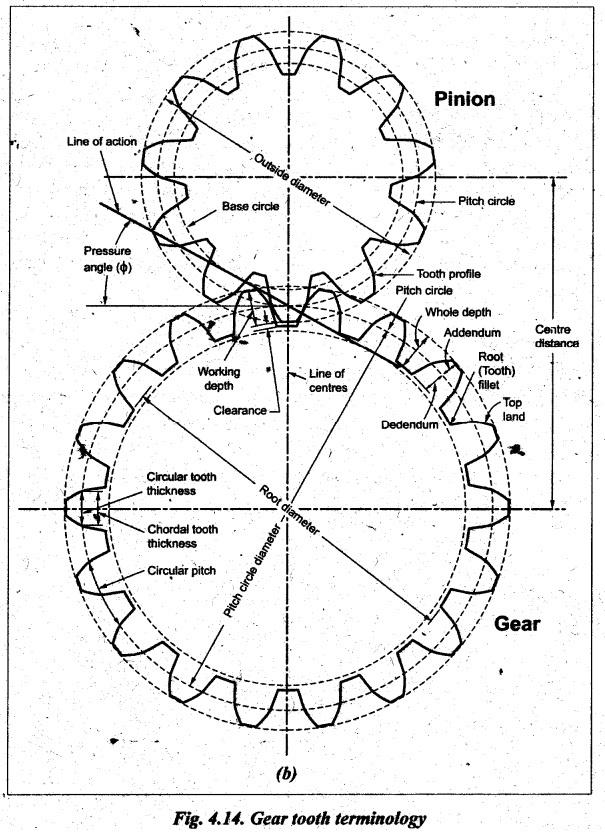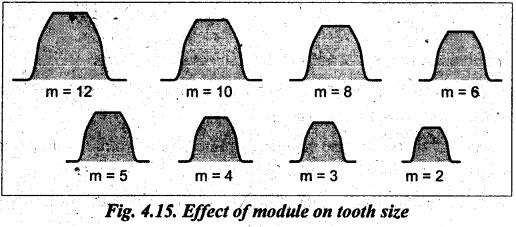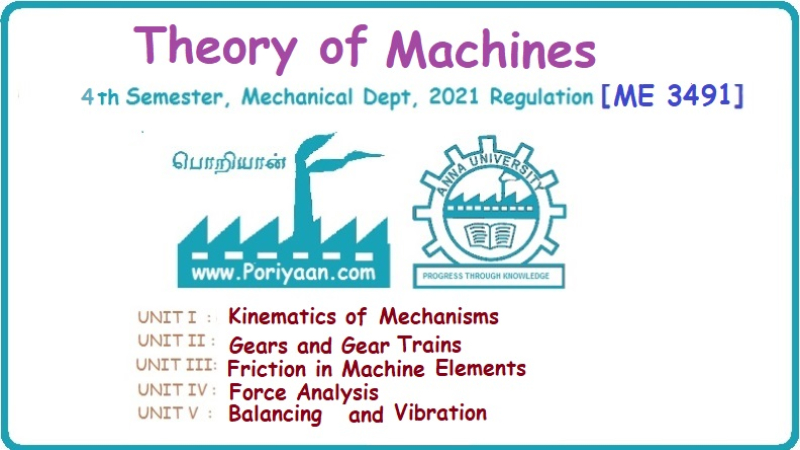Theory of Machines: Unit II: Gears and Gear Trains
Terminology used in gears (spur gear nomenclature)
Gears and Gear Trains - Theory of Machines
A pinion is the smallest of two mating gears. The larger one is called the gear or the wheel.
TERMINOLOGY USED IN GEARS (Spur Gear Nomenclature) The various terms used in the study of gears are illustrated in Figs.4.14(a) and (b). Though these terms are specific to spur gears, they are basic to all types of gears. 1. Pinion and gear: A pinion is the smallest of two mating gears. The larger one is called the gear or the wheel. 2. Pitch surface: Pitch surface is the surface of the imaginary rolling cylinder that replaces the toothed gear. 3. Pitch circle: • Pitch circle is an imaginary circle on gear, by which pure rolling action would give the same motion as the actual gear. • It is the imaginary circle upon which all gear parameters are measured. 4. Pitch circle diameter (D): • Pitch circle diameter is the diameter of the pitch circle. • The size of the gear is usually specified by the pitch circle diameter. • It is also called as pitch diameter. 5. Pitch point: Pitch point is a point on line joining centres of two mating gears, at which the two pitch circles meet. 6. Circular pitch (Pc): • Circular pitch is the distance measured along the circumference of the pitch circle from a point on one tooth to the corresponding on the adjacent tooth. • Mathematically, it is given by where D = Pitch circle diameter, and T = Number of teeth on gear. 7. Diametral pitch (Pd): • Diametral pitch is defined as the number of teeth per unit pitch circle diameter of the gear. • Mathematically; it is given by • The product of the circular pitch (pc) and the diametral pitch (pd) equals π. • The customary unit of diametral pitch is teeth/inch. 8. Module (m): • Module is defined as the ratio of pitch circle diameter to the number of teeth on the gear. • The module is the index of tooth size. • The customary unit of module is millimetre/tooth. • The standard modules as per Bureau of Indian Standards (BIS) for which cutters are readily available in the market are given in Table 4.1. [Source: PSG Design Data Book, Page No.8.2] Table 4.1. Standard modules • Effect of module on tooth size: As the module increases, the size of the gear tooth increases. The approximate tooth sizes for a few standard modules of choice 1 is in Fig.4.15. Note 1. The diameteral pitch is the standard for tooth size specifications in US customary units, whereas the module is the standard for tooth size specifications in SI units. That's why the term module is used widely for indicating tooth size of gears. 2. Although mating gears can have different diameters and number of teeth, mating gears must have the same module. 9. Top land: Top land is the surface of the top of the tooth. 10. Bottom land: Bottom land is the bottom surface of the tooth space. 11. Face of a tooth: Face of a tooth is the working surface of tooth profile lying above the pitch circle. 12. Flank of a tooth: Flank of a tooth is the working surface of tooth profile lying below the pitch circle. 13. Fillet: Fillet is the curved portion of the tooth flank at the root circle. 14. Addendum circle (or tip circle): Addendum circle is the circle drawn through the top of the teeth and is concentric with the pitch circle. 15. Addendum: Addendum is the radial distance of a tooth from the pitch circle to the top of the tooth. 16. Dedendum circle (or root circle): Dedendum circle is the circle drawn through the bottom of the circle. 17. Dedendum: Dedendum is the radial distance of a tooth from the pitch circle to the bottom of the tooth.. 18. Clearance: Clearance is the difference between the dedendum of one gear and the addendum of the mating gear. 19. Clearance circle: Clearance circle is a circle passing through the top of the meshing gear. 20. Total depth: • Total depth is the radial distance between the addendum and the dedendum of a gear. • In other words, Total depth = Addendum + Dedendum 21. Working depth: • Working depth is the radial distance from the addendum circle to the clearance circle. • It is equal to the sum of the addendum of the two meshing gears. 22. Tooth thickness: Tooth thickness, also known as circular thickness, is the width of the tooth measured along the pitch circle. 23. Tooth space: Tooth space, also known as tooth space width, is the width of space between the two adjacent teeth measured along the pitch circle.. 24. Face width: Face width is the width of the gear tooth measured parallel to its axis. 25. Backlash: • Backlash is the difference between the tooth thickness of one gear and the tooth space of the mating gear. • If the tooth thickness of a gear were equal to the value of tooth space of the mating gear, then the tooth geometry would have to be very precise to operate and also there would be no space available for lubrication of the tooth surfaces. To overcome these problems, practical gears are made with the tooth space slightly larger than the tooth thickness (the difference is called backlash). • To provide backlash, the cuter generating the gear teeth can be fed more deeply into the gear blank than the theoretical value on either or both of the mating gears. • The magnitude of backlash depends on (i) the desired position of the gear pair, (ii) the size of the gear, and (iii) the pitch of the gears. 26. Pressure angle (or angle of obliquity) (ϕ): • Pressure angle is the angle between the common normal to two gear teeth at the point of contact and the common tangent at the pitch point. • The standard pressure angles used are 14 ½°, 20° and 25°, • The effect of pressure angle on gears will be discussed in detail, in Section 4.10. 27. Path of contact: Path of contact is the path traced by the point of contact of two teeth from the beginning to the end of engagement. 28. Length of path of contact (or contact length): Length of path of contact is the length of the common normal cutoff by the addendum circles of the wheel and pinion. For more details, refer to Section 4.11. 29. Arc of contact: • Arc of contact is the path traced by point on the pitch circle from the beginning to the end of engagement of a given pair of teeth. • The arc of contact consists of two parts. They are: (a) Arc of approach: Arc of approach is the portion of the path of contact from the beginning of the engagement to the pitch point. (b) Arc of recess: Arc of recess is the portion of the path of contact from the pitch point to the end of the engagement of a pair of teeth. For more details on arc of approach and arc of recess, refer to Section 4.12. 30. Velocity (or speed ratio): • Velocity ratio is the ratio of speed of driving gear to the speed of the driven gear. where NA and NB = Speed of driving and driven gears respectively, TA and TB = Number of teeth on driving and driven gears respectively, and dA and dB = Pitch circle diameter of driving and driven gears respectively. 31. Gear ratio: • Gear ratio is the ratio of number of teeth on pinion to the number of teeth on gear wheel. where TP and TG = Number of teeth on pinion and gear wheel respectively, and r and R = Pitch circle radius of pinion and gear wheel respectively. 32. Contact ratio: • The ratio of the length of arc of contact to the circular pitch is known as contact ratio. • The value gives the number of pairs of teeth in contact. • For more details, refer to Section 4.13.









Theory of Machines: Unit II: Gears and Gear Trains : Tag: : Gears and Gear Trains - Theory of Machines - Terminology used in gears (spur gear nomenclature)
Related Topics
Related Subjects
Theory of Machines
ME3491 4th semester Mechanical Dept | 2021 Regulation | 4th Semester Mechanical Dept 2021 Regulation
